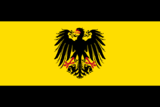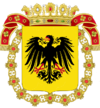Sacred Roman Empire
This article refers to a micronation or element of micronationalism which is defunct and no longer exists. You can help make the article reflect that or ask on the talk page for further information. |
Sacred Roman Empire | |
|---|---|
| Motto: "Reversi Sint in virtute" | |
| Anthem: Gott erhalte James den Kaiser | |
| File:North America | |
| Capital | (de facto) |
| Official languages | English, Spanish |
| Demonym(s) | New Roman |
| Government | Feudal Monarchy |
| Legislature | Imperial Court |
| Population | |
• Census | 31 |
| Currency | USD (de facto) |
| Time zone | (UTC) |
Website website coming soon | |
Not associated with the Holy Roman Empire | |
The Sacred Roman Empire (also known as the SRE) was a sovereign confederation of micronations based upon the ideas and practices of feudalism. The state was heavily based upon the Holy Roman Empire that existed in central Europe from 962 to 1806. The SRE was founded as a union with the purpose of offering smaller (generally weaker) nations defensive protection. Unlike most empires, the SRE was very de-centralized with each member state being responsible for their own foreign and internal affairs. The only unifying aspects of the empire were that all member states shared a collective military and trade policy, and all swore fealty to the Sacred Emperor; who ruled primarily as a figure head. Despite this, the Emperor was tasked with appointing nobles, dividing land and settling internal disputes between feudal states.
Etymology
The name of the empire came from a mis-translation of the Holy Roman Empire used in the Treaty of Westphalia. The name was adopted because while it symbolized what the nation stood for, it did not show a direct allegiance to any religious denomination (unlike the original).
History
The history of the SRE dated back to early August of 2019 with the breakup of the Organisation of Active Micronations. It was at that point that the long time union dissolved and left several of it's former member states in a precarious situation. It was from this international turmoil, that the empire was founded as a means of consolidating power among these micronations.
Kyberia
During the empire's first few weeks of existence, it was known as the Kyberian Imperial State (named after the capital of the Empire of Emosia). This name was quickly changed however as many saw it as "imperialistic" and "too self-serving" for Emosia.
Following much discussion on a possible replacement name, three finalists were selected. These were, the Second Holy Roman Empire, the Second Roman Empire or the Sacred Roman Empire. In the end, the latter was selected and on 23 September 2019, Kyberia was officially reincorporated as the SRE.
Government
As a feudal monarchy, every member state within the empire was responsible for running their own affairs, with the Emperor serving as ceremonial lord of all lands within the empire. In addition, the Emperor also served as commander-in-chief of the SRE's armed forces and as Chief Justice of the nation's legal system.
In addition to running their own states, the feudal Lords of the realm would meet (upon the Emperor's request) in a de fato "parliament", known as the Imperial Court to vote on new legislation to govern all member states within the empire. The court was also responsible for voting for the next Sacred Emperor (as the position was elected, not hereditary). Of this group, one was selected and thus appointed the role of Imperial President. This position was responsible for relaying all of the court's requests to the Emperor for final approval/dismissal and to serve as the Emperor's chief adviser.
Member states
The SRE is currently made up of two Imperial Estates (member states).

